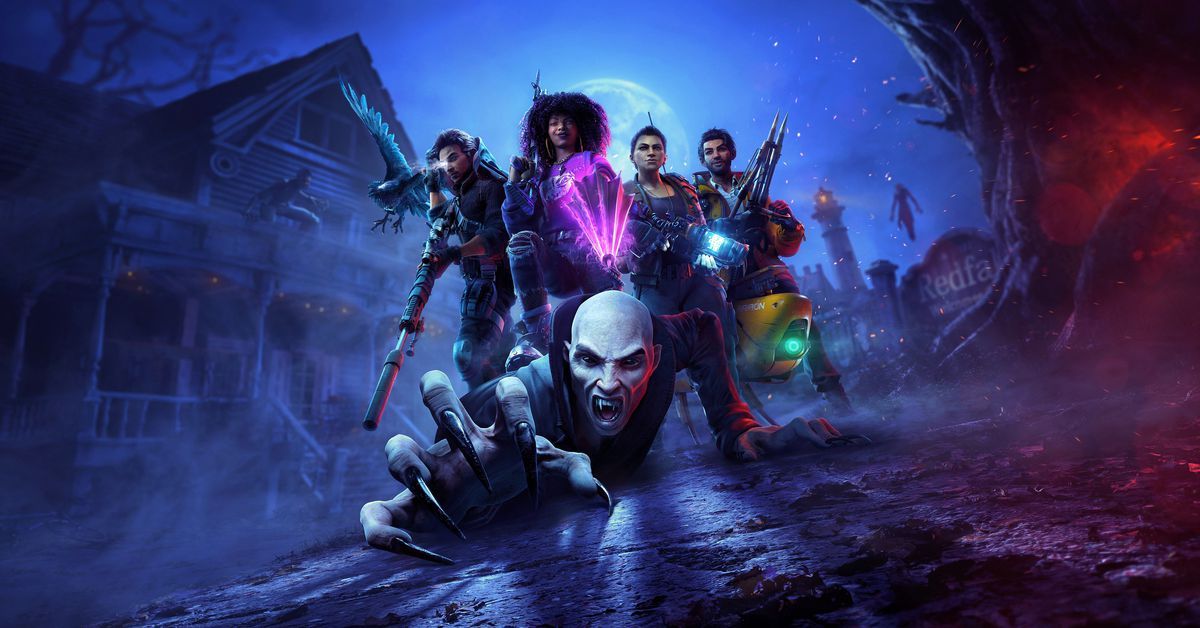Redfall is Arkane defanged
Stephen King’s Salem’s Lot opens with chapter upon chapter describing its cast of characters and the Maine town they inhabit. Before it becomes clear that a vampire has come to make their home its new feeding ground, King spends a lot of time sketching the history and culture of the populace. It’s an approach taken in plenty of monster stories: Give the audience a reason to care about a bunch of people before they’re preyed upon by bloodsucking ghouls.
Redfall, the latest from Arkane Austin, reverses this setup, introducing players to the titular, fictional Massachusetts island after vampires have drained most of the life from the place already. The result — roughly halfway through the story (our impressions are based on about 10 hours in a solo excursion) — is a game that struggles to warrant interest in the fate of its fallen town, and one that has a hard time finding fresh blood in overly familiar trends in the apocalypse genre.
As one of four characters, all of whom come with supernaturally tinged backstories and accompanying special abilities, the player sets out to investigate the nature of the vampire invasion, keep a group of fellow humans alive, and, hopefully, escape the island. The beginning isn’t very inspiring stuff. Redfall kicks off with the player establishing a safe base of operations — in this case, at a fire station — and helping a group of survivors settle into their new home. There’s a stern priest, a gentle doctor, and a grease-stained gun vendor, each with their own storefronts, and an attendant flock of other shallow NPCs. No member of this cast is particularly memorable, and it’s hard to drum up interest in their fates, mortal or not.
The town of Redfall itself makes a stronger impression. It features a downtown core lined with centuries-old colonial architecture and outlying tourist attractions, including a lighthouse and museum, marking its history as a whaling center. Because there are few backdrops for a horror story better than mid-autumn, the town sits beneath grand orange-, yellow-, and red-leafed trees; many of its storefronts are decorated with pumpkins.
These locations, along with others— a dried-out, fish-strewn lake bed or a shadowy, abandoned hospital, to name a couple more — create a stylish sense of menace enhanced by splashes of bold red ’80s paperback font across menus and area names. As expected of Arkane, a studio known for creating a strong sense of place in its games through elaborate set dressing, the interiors of these spaces are crammed with everyday items and scraps of discarded writing. These details inform the nature of the characters who once lived there, hinting at the dark secrets underlying the vampires’ takeover.
The atmosphere dissipates, though, when enemies reveal themselves to not be the terrifying otherworldly creatures, ruthless private military operatives, or vicious human cultists that the game purports them to be, but rather, numb-skulled shooting gallery targets. A highly trained soldier responds to the first volley of gunfire by running headlong into the corner of a movie theater, just waiting to be plinked in the head with a rifle shot. A creature of the night launches a demonic attack by floating in a straight line toward the player, teleporting away from a hail of bullets to back up a little bit and try the same tactic once again. While the enemies occasionally demonstrate a bit more creativity — vampires sometimes zigzag around the screen to dodge gunshots, and some humans set up automated gun turrets — they’re largely brain-dead, presenting a real threat only when they swarm the player and obscure one’s vision.
It’s worth noting that the aiming is floaty enough on Xbox Series X that the best battlefield tactic is usually to strafe from side to side with a shotgun, blasting at cultists and vampires when they maneuver their way into the crosshairs. Switching to Windows PC helped with this sluggish movement — and the camera’s general choppiness — but the gunplay is still unexceptional. This is a problem, given how much shooting must be done to wade through Redfall’s masses of cultists, soldiers, and vampires in any given mission.
Playing as Layla Ellison, a university student with telekinesis, is an enticing wrinkle to standard shooter design. But her suite of special powers doesn’t do much to mix up combat that’s largely dependent on mowing down waves of goons with whatever gun has the highest damage number listed in its description. Layla can pop a big purple psychic umbrella that acts as a shield, and she can also call in her ghostly vampire ex-boyfriend to float around clawing at foes. But these powers, along with her ability to summon a glowing midcentury elevator cage that shoots her or other players up into the air, rarely lend texture to the flat, unexciting gunfights.
Related Redfall will be locked to 30 fps on Xbox at launch
A narrative that fleshes out Redfall’s excellent sense of place could help overcome its lackluster combat. So far, the story hasn’t provided much impetus to press forward through mission after mission of decent exploration and drab gunplay. The incidental writing — found in places like old notes or flashback scenes captured in spectral dioramas — is evocative enough to color in the broad strokes of the plot with an eeriness and human drama it otherwise lacks.
If this tone takes center stage in the back half of the story, combined with plot developments that add some momentum to the proceedings, it may be easier to overlook the game’s weaker aspects and appreciate it as a compelling narrative work. At this point, though, the town of Redfall is sucked too dry of liveliness for players to be invested in whether its vampires triumph or not.
Redfall will be released May 2 on Windows PC and Xbox Series X. The game was reviewed on Xbox and PC using a pre-release download code provided by Bethesda Softworks. Vox Media has affiliate partnerships. These do not influence editorial content, though Vox Media may earn commissions for products purchased via affiliate links. You can find additional information about Polygon’s ethics policy here .
Source: Polygon


